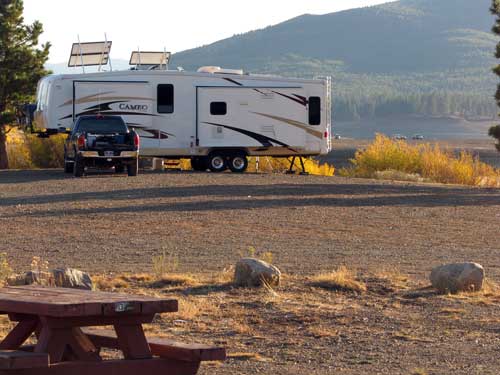 |
|
Our Personal Experiences
While Boondocking |

|
|
| When we first began using an RV nearly ten years ago, we knew nothing of boondocking (also called dispersed camping or dry camping). I think we actually camped a few times in National Forests, perhaps in a wide spot in the road but we didn't know that kind of camping had a name. It has been a long, slow learning process for us to get to the point which we actually prefer dispersed camping. Not just because it is usually free parking but because we enjoy the space between us an other campers, the ability to let our dog, Morgan out the door without having to run for a leash first and the sounds of nature around us without the sounds of generators, TVs, radios, other camper music ... the quiet. We first learned of boondocking as a lifestyle from George. George is a single man who travels the USA and Mexico in his Class C motor home and always boondocks (or dry camps ... a term used when in a city). He writes a blog about his adventure with the goal of teaching others how to camp free. So we followed George's blog for several years (and still do check in occasionally) to learn how to camp free. Sometimes it's easy and sometimes it's a challenge but it is enjoyable all the time. The stories below will tell you of our experience and hopefully be of help to others thinking of this lifestyle. The photo above is of our only home parked at Boca Reservoir near Truckee, California in October, 2009. This is a National Forest campground but free parking because we are parked here in the off season. The right side of our trailer is facing the south because that's where the sun is this time of year. We gather sun on our solar panels (they are standing on the trailer roof aimed directly at the sun) to charge our batteries, we currently don't own a generator. When the right side of our trailer is faced south, we also get the benefit of the sun warmth through our windows which are mostly on that side of the trailer. The high temperatures during October have been in the 50s and 60s but lows have been 20s and 30s so we LIKE the sun through our windows this time of year. |
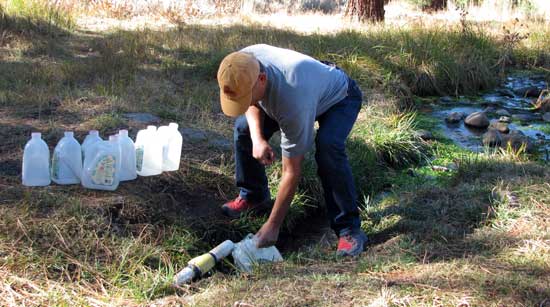 |
| Sunday, October 25, 2009: We have a freshwater tank in our trailer which holds 85 gallons of water. When we first began camping, the tank would last almost a week if we were lucky. Now we can make this tank of water last three weeks. One of the methods we use to extend the water in the tank is to keep gallons of fresh water in the kitchen and bathroom to use as drinking water, to make coffee or tea and for hand/face washing plus brushing teeth. We've learned to save the tank water for shower water and perhaps dish washing although if we really must conserve, we'll heat up the water from our gallons for dishwashing too. I created an interesting little video while I was gathering water from Boca Spring above. Spring water is a real treat. Boca Spring is located near Truckee, California. You can click the photo above to start the video. By the way, we like Arizona Tea and have found that their gallon containers are very sturdy and easy to keep clean so we use them to collect our gallons of water. |
 |
There are no springs near our campsite like the one we found above at Boca Springs, so we must buy our drinking water for 25¢/gallon. If the folks in California had to pay 25¢/gallon there wouldn't be such a water shortage in California. This is not as good as the Boca spring water but our cheapest source for drinking water. "RO" is "reverse osmosis", it's not enough to just filter the water in Arizona, it must be treated further for drinking quality. Note the same "Arizona Tea" gallon jugs I used at Boca spring. These machines are located in several locations around Quartzsite and I've seen them in Yuma also. My assumption is that they are located in many location Arizona. |
|
| Tuesday, November 24, 2009: We are currently parked about 2 miles from the nearest water source in the Arizona desert. We certainly don't want to move our trailer to refill our freshwater holding tank. The photos below show how we restock the freshwater tank. My method is a copy of Camping World's answer to the problem |
|
| but cheaper. Other than drinking water, we need water in our trailer freshwater holding tank for showers, and other washing activities. I use a large ice chest (100 quart) with a valve installed on the drain. I haul the chest on top of my Transfer Flo tank. I fill the chest from a local water source. Currently, that happens to be a local park where I'm charged 5¢/gallon for city water. Before I flipped the axles on the trailer, the chest was high enough to gravity feed the water into the trailer, but now that the trailer is taller, I must pump the water into the trailer holding tank. I purchased one of the cheap water pumps which attaches to my cordless drill. It takes about ten minutes to pump the 25 gallons into the tank. I keep the ice chest in the back of the truck. Yes, it takes up room but is handy when we go grocery shopping. I included the photo of the drill battery charging because I wanted to be able to ask you this question. Where do you think the power is coming from to recharge the drill battery, since we are parked in the middle of the desert? From the sun, of course. |
|
|
Friday, November 27, 2009: It's fall/winter 2009-2010 and we are parked in the Arizona desert about 2 miles from the nearest paved road. I noticed an ad in one of the local newspapers announcing full hookups at an RV park for $145/month plus the cost of electricity. So why would someone install $3,800 in solar power generation and endure limited water and sewer capability if you can park with full hookups for only $145/month. First, we aren’t as “solar pure” as some of those parked around us. We DO enjoy 50 amp connections and all the water we can run down the drain. When we are “connected to the grid” it’s like resort living to us. No more counting watts and amps and limiting our TV and Internet usage.
I drove to two local RV parks to check out the situation. The RV park with a palm tree at each site (above photo on the left) was $350/month plus electricity. The other photo is a “gravel park” for $250/month plus electricity. Both parks charge $.20/kwh for electricity. The palm park is bordered between I-10 and Main Street in Quartzsite. The gravel park is just off busy Highway 95 north of Quartzsite. I was informed by both parks that there was NO space available in January so there are plenty of campers who find these parks attractive. We certainly don't find either park attractive for many reasons. When we first started noticing boondockers, we found all shapes and sizes of RVs camping in the desert. Many are the huge bus style motor homes costing much more than our fifth wheel. So it’s not that boondockers are dirt poor (like we are) and can’t afford to pay for a monthly RV space, there is something else going on. We enjoy our space and a quiet surrounding. Our nearest boondock neighbor is 100 yards and they are friends. We don’t hear their activity and they don’t hear ours. We don’t worry about having Morgan on a leash nor do we worry about Annie getting into traffic. When we look at the 180° view from our “patio” we see the desert, not other trailers, city lights and traffic. However, boondocking is often a social experience where RVs are parked close to each other for fellowship. We do some of that at our Escapee rallies but enjoy the solitary experience more. Some boondockers travel only in groups. Gwen enjoys knitting and reading in a quiet location. My favorite activity is bicycling, in this case, mountain biking on the many remote desert roads. Parking 2 miles from the nearest pavement gets both of us exactly what we want. One interesting point, we’ve been free to travel since June, 2009, so about 6 months. In that time, we have generated and used 4,680 kwh of power. At $.20/kwh that’s $936. Perhaps it won’t take as long as I thought to breakeven on my solar investment. Hopefully you only have to look at the above RV park photos and the photo of our current location to understand why we prefer the open desert camping. |
| Saturday, December 19, 2009: This little tip may seem obvious but I've seen RVers do some pretty silly things with their RV mats to keep them from blowing away. If we are camped for more than a day, we usually put out our mat to help keep the dirt from coming into the RV and to make a nice 9 x 12' outside addition to our living space. It also makes this outdoor living space move comfortable. The mat must be tacked down or it will likely cause problems in even a lite wind. I use nails about 8" long with a washer to tack each mat corner and edges to the ground. These aren't spikes (I use spikes to tie down the awning). Spikes are two large in diameter, these nails are about the diameter of a 16d nail. If you hit a larger rock, they will likely bend so I keep extra nails on hand. I used these nails in desert, rocky ground and they've always worked well. When it's time to leave, they are easy to pull out of the ground. |
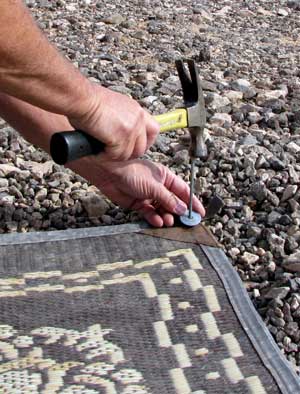 |
|
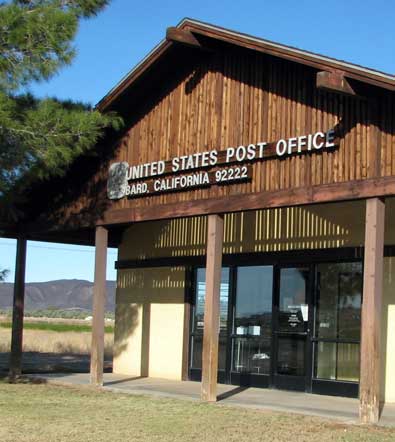 |
Tuesday, February 16, 2010: Today was a lesson learned in dealing with the post office. Of course, we have done our best to reduce our paper mail to ZERO. But we still have a few pieces of mail we must get like a new Verizon phone from Mindy, my daughter, and some medications for Gwen forwarded from my son Ben. First, the positive, while camped at the Imperial LTVA we used the tiny post office at Bard, CA 92222 located about ten miles from Yuma in the middle of the agricultural area. Extremely good customer service and a friendly attitude. This is a single postal employee post office. Now for the negative. While sitting in the desert, we looked ahead at Tucson for a post office. I did an Internet search for Tucson post offices and found one only 5 miles from our camping location. I asked Mindy and Ben to send the mail to General Delivery |
|
| at this Tucson branch. After arriving at our Tucson camping location we learned that this branch was really a carrier preparation station with the only public access for package pickup. The staff DID listen to our request for delivery of the two pieces of mail and reluctantly gave us the pieces. They lectured us to NOT use this location for "general delivery" and said how lucky we were that the mail was not returned which is normal procedure. So here is what we learned and what I would recommend when dealing with the post office. First, try to use only the small post offices. Second, usually when doing an Internet search you'll find a phone number for the post office, call them to learn how they handle general delivery mail. Third, be sure the sender puts a clear return address on the envelope. The USPS says they will hold general delivery mail for 30 days. |
Monday, October 11, 2010: You'll see my invention for washing clothes below. Well Gwen doesn't like it so much. I broke the lid the first wash so now my bucket and plunger washer splashes everywhere and I haven't solved the problem of the plunger sticking to the clothes and to the bottom of the bucket. The Wonder Washer is what Gwen likes. We just got it a few days ago and I'll admit it works much easier than my bucket and plunger method. We use it at the counter next to the kitchen sink because we can easily add water from the kitchen faucet (it's on a sprayer hose) and we can drain the dirty wash water directly into the sink. I actually used it myself several times. I like to wash my riding clothes immediately after a bicycle ride because they are soaked with sweat. The Wonder Washer is what Gwen likes. We just got it a few days ago and I'll admit it works much easier than my bucket and plunger method. We use it at the counter next to the kitchen sink because we can easily add water from the kitchen faucet (it's on a sprayer hose) and we can drain the dirty wash water directly into the sink. I actually used it myself several times. I like to wash my riding clothes immediately after a bicycle ride because they are soaked with sweat. The Wonder Washer has suction cup feet so it stays put on the counter top. Following the instructions, water and laundry soap is put into the washer first then I just add the riding clothes to the opening in the top. The
has suction cup feet so it stays put on the counter top. Following the instructions, water and laundry soap is put into the washer first then I just add the riding clothes to the opening in the top. The |
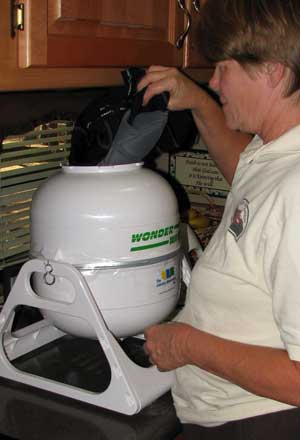 |
|
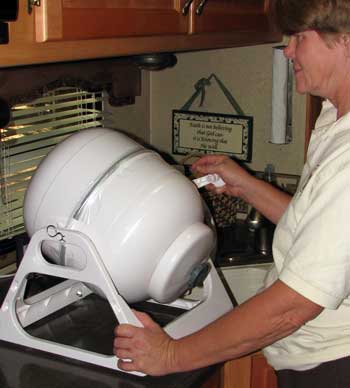 |
lid has a secure rubber gasket and a screw knob to be sure the lid won't fly off. I will admit, the second time I used it, I failed to double check the lid and I had not locked it correctly so it came off and I had water all over the counter. Now I double check EVERY time I use the washer. It's really easy to use warm or hot water to wash. The instructions say to crank once per second which seems slow to me but works fine. It also suggests cranking for only 2 minutes. I definitely crank longer and/or let the clothes soak in the soapy water for a while after cranking. To drain, I snap on the drain pipe to the spring loaded drain connector. Water gushes into the sink. When I release the lid, the rest of the water drains into the sink. I snap off the drain pipe with a quarter turn and run rinse water into the |
washer. After a little more cranking I drain for the final time and pull the clothes out the top squeezing the water out of them. They are ready to line dry. The water is really dirty and the clothes don't smell like sweat so it must be working well. The Wonder Washer is easy to assemble. It took me about 15 minutes with everything snapping together, no tools needed. It also came with an extra handle. I assume the handle might be the first to wear out if someone like me cranks too hard. I was surprised how fast it arrived when ordered. I think they must have shipped it the same day I ordered. It's not expensive. If you want to see ordering information just click one of the Wonder Washer is easy to assemble. It took me about 15 minutes with everything snapping together, no tools needed. It also came with an extra handle. I assume the handle might be the first to wear out if someone like me cranks too hard. I was surprised how fast it arrived when ordered. I think they must have shipped it the same day I ordered. It's not expensive. If you want to see ordering information just click one of the Wonder Washer links.
links. |
|
Tuesday, June 8, 2010: Here's a way to save a quarter or two. We are often quite a distance from the nearest laundromat and as the laundry piles up it can cost as much as $30 to clean it. Here is a way to clean a small load of wash and keep up with the laundry so it doesn't build up while we are parked in a remote location. WalMart sells 5 gallon buckets and lids. Drill a hole in the lid to fit a standard plunger handle. Half fill the bucket with water, a little laundry soap, drop in the laundry and use the plunger as an agitator to wash the clothes. Rinse, wring and hang up to dry. You've saved a quarter.
Some RVers just use the 5 gallon bucket, lid, water, soap, laundry and put in their vehicle as they drive around town. The water sloshing around while driving washes the clothes. Either way, you've saved a quarter.
Here's a funny video to see the idea in action. |
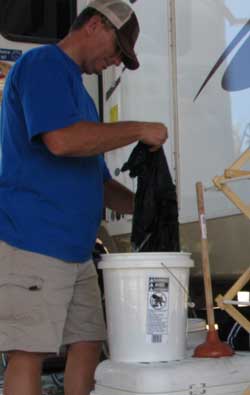 |
|
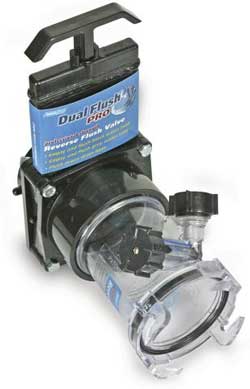 |
Tuesday, October 5, 2010: I purchased this handy item for use during boondocking. This is the Dual Flush Pro Holding Tank Rinser used to flush the black water tank when boondocked. Just click the link to get ordering information and free shipping. Our fifth wheel has an internal black tank flush as most recent RVs have. But you must have easy access to a water hose to power the black tank flush. At most drive-up dump locations, there is no easy access to water so here is where you use this flush method. Install the Dual Flush Pro to your sewer drain then your sewer hose to the DF Pro. Open the DF Pro gate valve and drain the black water tank first as you normally would. Once the black water is drained, close the DF Pro gate valve and open the gray water drain valve but leave the black water drain valve open. This forces gray water into the black water tank. After enough time to fill the black tank, release the DF Pro gate valve which will allow the black and gray water tanks to used to flush the black water tank when boondocked. Just click the link to get ordering information and free shipping. Our fifth wheel has an internal black tank flush as most recent RVs have. But you must have easy access to a water hose to power the black tank flush. At most drive-up dump locations, there is no easy access to water so here is where you use this flush method. Install the Dual Flush Pro to your sewer drain then your sewer hose to the DF Pro. Open the DF Pro gate valve and drain the black water tank first as you normally would. Once the black water is drained, close the DF Pro gate valve and open the gray water drain valve but leave the black water drain valve open. This forces gray water into the black water tank. After enough time to fill the black tank, release the DF Pro gate valve which will allow the black and gray water tanks to |
| drain completely. You've just flushed the black water tank using your gray water to do it. The hose connections on the DF Pro are an extra bonus used to unblock a sewer line clogged at one of the valves or between the valve and sewer connection. |
|
Monday, July 1, 2013: I'm returning to a discussion of boondock camping after being away from long term boondocking for various reasons. If you are new to boondock (dry) camping, you might scroll up and read what I said previously. We've recently switched from our 16,000 lb fifth wheel to this 9,000 lb "bumper-pull" because both the Dodge and I were getting tired of towing such heavy weight. We still own the Cameo fifth-wheel but keep it permanently parked at our lot in Oregon's only Escapee park, Timber Valley in Sutherlin. The Alumascape was good for nothing but traveling from one RV park to another until I made many changes and additions. The trip pictured at the right was into the Deschutes National Forest near Sisters, Oregon and our first boondock trip (when you follow this link, scroll UP to see the entire trip) with the changes made to the trailer. It was a short, twelve day, trip but we are working out the bugs 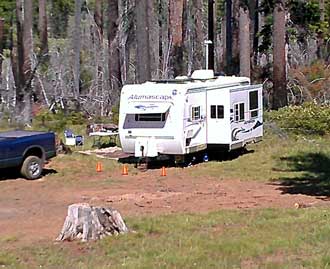 knowing we will likely spend as much as four to six months traveling in the Alumascape and most of it will be boondocked. Our questions are being answered with these short trips. Questions such as: How long will the fresh water last? ... How long will the black water tank last before we must move to dump that tank? ... Will two batteries be enough power (we had four batteries in the Cameo)? ... Does the lighter weight and shorter trailer allow us to get into spots we couldn't with the Cameo? ... Is the shorter trailer noticeably less comfortable than the (longer) Cameo? ... How much do we miss TV (we aren't taking a TV with us while traveling with the Alumascape)? ...What else needs to be done to make the trailer more comfortable? knowing we will likely spend as much as four to six months traveling in the Alumascape and most of it will be boondocked. Our questions are being answered with these short trips. Questions such as: How long will the fresh water last? ... How long will the black water tank last before we must move to dump that tank? ... Will two batteries be enough power (we had four batteries in the Cameo)? ... Does the lighter weight and shorter trailer allow us to get into spots we couldn't with the Cameo? ... Is the shorter trailer noticeably less comfortable than the (longer) Cameo? ... How much do we miss TV (we aren't taking a TV with us while traveling with the Alumascape)? ...What else needs to be done to make the trailer more comfortable?
Boondock camping has pros and cons. First the cons: 1)It will likely be dirty compared to camping in a paved RV park. No one prepares the "wilderness" for your arrival in an RV and you must come up with methods of controlling dust/mud/dirt/twigs/grass. 2)You might be camped alone. We were alone when camped in the Deschutes. Novice boondockers often ask about "security" when camped alone. It takes doing it to get use to the feeling and soon you feel "safe". We know of no horror stories coming from boondockers. We do leave our trailer to hike and do tourist things and have never had items stolen. It will help your feeling of security if you boondock with a friend. However, we DO know of theft in Quartzite, AZ where boondockers are usually camped in groups. Having insurance helps me feel comfortable about leaving the trailer to site-see. RV parks are no more secure, I know of theft in several RV parks. 3)You must pay attention to power, water and sewage usage. We solved the power usage by installing solar panels which serves 95% of our power needs. A generator does the rest (for example, to run the vacuum cleaner or microwave, it does NOT have the power to run our air conditioning). We get fresh water in a 25 gallon ice chest and drain it into the trailer holding tank. Gray water is let loose on the mountain floor. We were able to go one month on our black water tank in the Cameo and don't know how long we can go in the Alumascape, it had no problem with 12 days. When in an RV park, you give NO thought to any of this. 4)No cable TV (or WIFI). We use to carry our own satellite dish for TV but that can be a hassle so have switched to satellite radio which is NO hassle. Yes, we can get EVERY NFL football game plus Wimbledon and US Open tennis on satellite radio. For WIFI, we use our smart phones (which don't always work in the wilderness). 5)Too far to the grocery store. Yes, sometimes it's a drive (like when we are parked in Bouse, Arizona, it's 25 miles to a decent grocery store), but not always. 6)The National Forest, BLM and National Grassland 14 day limit can be a hassle (because you must pack and move when you've found a comfortable parking location). Sometimes the "authorities" pay attention to the 14 day limit and sometimes not. 7)Lack of nearby conveniences such as the RV park laundromat, pool, hot tub, craft room, woodshop, etc. Yup! For some, those are worth $650 - $1,500 per month. Now for the Pros to boondock camping: 1)It's free. Although the difference between free and $8 per night isn't much ($8 at some National Forest campgrounds with NO hookups with a Senior Access card). Although, $8 per night IS $240/month. 2)No hassle about our animals. Annie does not have to be caged and Morgan does not have to be on a leash. 3)It's quiet. No noisy traffic or neighbors. 4)It's GREEN when you aren't using a generator. Generally, we never have to use a generator except to use the vacuum cleaner. Everything else runs off our solar panels and batteries. 5)Lots of space, your slide isn't 5 feet from your neighbor. 6)Usually a scenic setting of YOUR choosing, and you don't have to pay extra to park next to the river, lake, creek or ocean. Obviously, the answer for us is boondock camping. The pros for wilderness camping and the cons of RV park camping are enough for us to choose boondocking when we can.
Having said all this, we did find it next to impossible to boondock on our trip into Texas and further east and north. Not necessarily because the boondock locations aren't as plentiful as in the west but because of the heat and canopy. We found the heat and humidity to be high enough to need "shore-power" each day to run our air conditioning. Additionally, the deciduous tree canopy is so thick, the sun is blocked so, no solar power. Fortunately, we also learned that virtually every Army Corp of Engineers Campground (and there are many) came with power and water hookups. Additionally, those campgrounds were usually only $12 per night with our Senior Access Pass.
|
| |
|
|



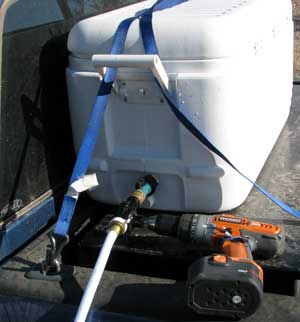
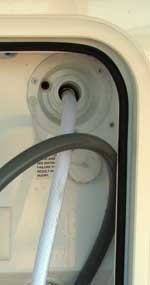

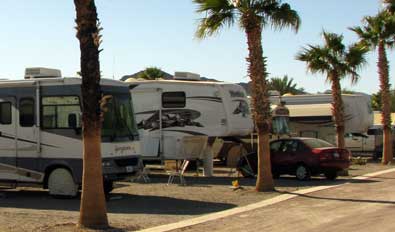
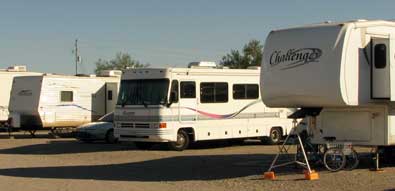






 knowing we will likely spend as much as four to six months traveling in the Alumascape and most of it will be boondocked. Our questions are being answered with these short trips. Questions such as: How long will the fresh water last? ... How long will the black water tank last before we must move to dump that tank? ... Will two batteries be enough power (we had four batteries in the Cameo)? ... Does the lighter weight and shorter trailer allow us to get into spots we couldn't with the Cameo? ... Is the shorter trailer noticeably less comfortable than the (longer) Cameo? ... How much do we miss TV (we aren't taking a TV with us while traveling with the Alumascape)? ...What else needs to be done to make the trailer more comfortable?
knowing we will likely spend as much as four to six months traveling in the Alumascape and most of it will be boondocked. Our questions are being answered with these short trips. Questions such as: How long will the fresh water last? ... How long will the black water tank last before we must move to dump that tank? ... Will two batteries be enough power (we had four batteries in the Cameo)? ... Does the lighter weight and shorter trailer allow us to get into spots we couldn't with the Cameo? ... Is the shorter trailer noticeably less comfortable than the (longer) Cameo? ... How much do we miss TV (we aren't taking a TV with us while traveling with the Alumascape)? ...What else needs to be done to make the trailer more comfortable?